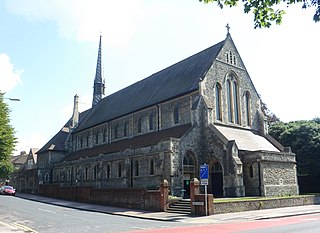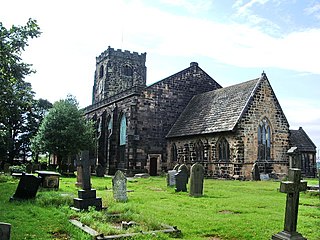
Llanwarne is a village and civil parish in Herefordshire, England. The population of the civil Parish as taken at the 2011 census was 380. It is about 5 miles (8 km) from the Welsh border, is approximately 6 miles (10 km) north-west of Ross-on-Wye, and near Harewood End and Pencoyd.

St Mary's, Harrow on the Hill, is the Borough and Parish Church at Harrow on the Hill in northwest London, England. It is a Grade I-listed building.

Swineshead is a village and civil parish in the Borough of Bedford in the county of Bedfordshire, England.

Hackney was a parish in the historic county of Middlesex. The parish church of St John-at-Hackney was built in 1792, replacing the nearby former 16th-century parish church dedicated to St Augustine. The original tower of that church was retained to hold the bells until the new church could be strengthened; the bells were finally removed to the new St John's in 1854. See details of other, more modern, churches within the original parish boundaries below.

St John at Hackney is a Grade II* listed Anglican Church in the heart of the London Borough of Hackney with a large capacity of around 2,000. It was built in 1792 to replace Hackney's medieval parish church, of which St Augustine's Tower remains, at the edge of its churchyard. The church faces north towards Clapton Square, with the nearby Sutton House and Hackney Central station also accessible from the churchyard to the east and south, respectively. As well as a thriving parish church, St John at Hackney has also become known as a notable music venue, playing host to the likes of Coldplay, Ed Sheeran, Emeli Sande, Robbie Williams, Griff and Interpol.

St Peter le Poer was a parish church on the west side of Broad Street in the City of London. Established before the end of the 12th Century, it was rebuilt in 1540, and again in 1792 to a design by Jesse Gibson with a circular nave. It was demolished in 1907.

St Mary Magdalene Woolwich is an 18th-century Anglican church dedicated to St Mary Magdalene in Woolwich, southeast London, England.

St John the Evangelist's Church is an Anglican church in the Preston Village area of Brighton, in the English city of Brighton and Hove. The Grade II listed building, designed by Sir Arthur Blomfield, was started in 1901 but did not take its present form for another quarter of a century. In the meantime, the nearby parish church of Preston was severely damaged by fire, and the new church was granted the parish church status which it still retains.

St Chad's Church is an Anglican church in Poulton-le-Fylde, Lancashire, England. It is an active parish church in the Diocese of Blackburn and the archdeaconry of Lancaster. It is recorded in the National Heritage List for England as a designated Grade II* listed building. A church on the site was built no later than the 11th century and may have existed prior to the Norman Conquest of England. The tower dates from the 17th century, and much of the remainder of the building from a major renovation in the 18th century, although some of the fabric of the original structure remains. Further renovation and additions took place in the 19th, 20th and 21st centuries.

St Wilfrid's Church is an Anglican church in the village of Ribchester in Lancashire, England, which is situated close to the site of a Roman fort. It is an active parish church in the Diocese of Blackburn. It is recorded in the National Heritage List for England as a designated Grade I listed building.

St Bartholomew's Church is in the town of Colne in Lancashire, England. It is an active Anglican parish church in the Diocese of Blackburn. There has been a church on the site since no later than the 12th century although the present building mostly dates from the 16th century. It is recorded in the National Heritage List for England as a designated Grade I listed building.

The Church of St Mary and All Saints is an Anglican church in the village of Whalley, Lancashire, England. It is an active parish church in the Diocese of Blackburn. A church probably existed on the site in Anglo-Saxon times and the current building dates from the 13th century. It is recorded in the National Heritage List for England as a designated Grade I listed building.

The Church of St Mary the Virgin is an Anglican church in Goosnargh, a village north of Preston in Lancashire, England. The church dates from the Middle Ages; it was enlarged in the 16th century and restored twice in the 19th century.

St Helen's Church is an Anglican church in the village of Churchtown in Lancashire, England. Historically, it was the parish church of Garstang; today, as Garstang is split into more than one ecclesiastical parish, St Helen's parish is Garstang St Helen (Churchtown). It is in the Diocese of Blackburn. It has been designated a Grade I listed building by English Heritage. St Helen's is known as the "cathedral of The Fylde".

St Andrew's Church is an Anglican church in Leyland, Lancashire, England. It is an active Anglican parish church in the Diocese of Blackburn and the archdeaconry of Blackburn. The church is recorded in the National Heritage List for England as a designated Grade II* listed building.

St Bartholomew's Church is in the town of Great Harwood in Lancashire, England. It is an active Anglican parish church in the Diocese of Blackburn. The church is recorded in the National Heritage List for England as a designated Grade II* listed building.

St Wilfrid's Church is an Anglican church in Halton-on-Lune, a village in the English county of Lancashire. It is an active parish church in the Diocese of Blackburn and the archdeaconry of Lancaster. Halton may have been the site of an ancient Anglo-Saxon minster. Of the current structure, the tower dates from the 16th century and the remainder was built 1876–77 by Paley and Austin. The church is recorded in the National Heritage List for England as a designated Grade II listed building.

St Mary the Virgin, Mortlake, is a parish church in Mortlake, in the London Borough of Richmond upon Thames. It is part of the Church of England and the Anglican Communion. The rector is The Revd Canon Dr Ann Nickson.

St Mary, Haggerston, was an Anglican parish church built to the designs of John Nash in 1827, in what is now the London Borough of Hackney. Built in the Gothic style of its time, it had an elaborate west front with a disproportionately tall tower. The rest of the church was, in comparison, rather plain. It was altered later in the 19th century by James Brooks as the first initiative of the Haggerston Church Scheme, and destroyed by bombs during the Second World War. The site is now a children's playground west of Haggerston Park, between Thurtle Road and Queensbridge Road.

The Old Church is an arts venue in Stoke Newington, London Borough of Hackney, formerly the medieval and Tudor church of St Mary's Church or St Mary's Old Church. It is a Grade II* listed building.























